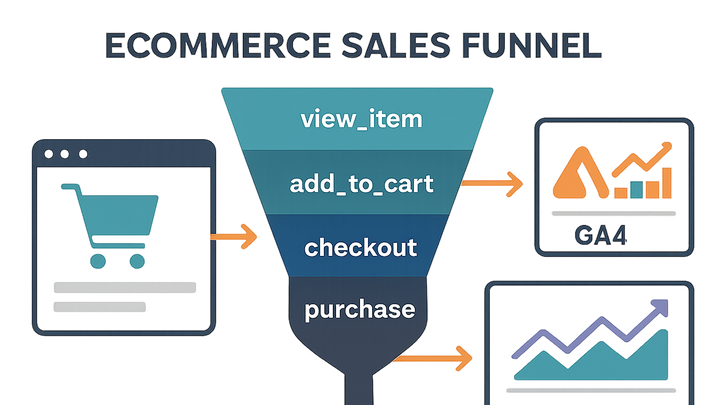Published on 2025-06-27T20:10:27Z
What is Ecommerce Tracking? Examples of Ecommerce Tracking
Ecommerce tracking refers to the process of monitoring and analyzing user interactions related to online purchasing activities on a website or mobile app. This includes capturing events like product impressions, add-to-cart actions, checkout initiations, and purchase completions. By collecting these data points, businesses can measure conversion rates, identify drop-off stages in the sales funnel, and optimize the user experience to boost revenue. Google Analytics 4 (GA4) provides built-in ecommerce tracking features through enhanced ecommerce events and customizable parameters. PlainSignal, a cookie-free analytics platform, offers a lightweight JavaScript snippet for simple ecommerce tracking without compromising user privacy. Implementing ecommerce tracking with tools like GA4 and PlainSignal enables data-driven decision making, better marketing attribution, and continuous improvement of the online shopping experience.
Ecommerce tracking
Track product views, cart additions, and purchases to measure revenue and optimize the ecommerce funnel.
Why Ecommerce Tracking Matters
Ecommerce tracking provides critical insights into how users interact with an online store, enabling data-driven optimizations that drive revenue growth.
-
Understand customer behavior
Track how users browse products, add items to their carts, and complete purchases to identify key drop-off points.
-
Optimize marketing spend
Allocate budget to the most effective channels by analyzing which campaigns and traffic sources generate the highest revenue.
-
Improve user experience
Use funnel analysis and conversion data to streamline the checkout process and reduce friction in the shopping experience.
Types of Ecommerce Tracking
Different levels of ecommerce tracking offer varied depths of insight, from basic transaction counts to detailed user interaction data.
-
Basic ecommerce tracking
Captures simple transaction data such as total revenue and order count, requiring minimal setup in most analytics platforms.
-
Enhanced ecommerce tracking
Provides granular insights on product impressions, promotions, checkout steps, and refunds, supported natively by GA4.
-
Event-based tracking
Enables custom event definitions for bespoke analytics, ideal for platforms like PlainSignal to track unique user actions.
Setting Up Ecommerce Tracking in Google Analytics 4 (GA4)
GA4 simplifies ecommerce measurement with built-in events and customizable parameters, requiring setup in your property’s Data Stream and Admin settings.
-
Enable ecommerce reporting
In GA4 Admin, under Data Streams, enable Enhanced Measurement and toggle on ecommerce reporting to activate the ecommerce reports.
-
Configure data streams
Install the gtag.js snippet or Google Tag Manager container on all pages to start collecting pageview and event data.
-
Define ecommerce events
Register standard ecommerce events like view_item, add_to_cart, begin_checkout, and purchase with respective parameters.
-
Purchase event
Implement gtag(‘event’, ‘purchase’, { transaction_id: ‘T123’, value: 99.99, currency: ‘USD’, items: […] });
-
Add to cart event
Use gtag(‘event’, ‘add_to_cart’, { items: [{item_id: ‘SKU123’, item_name: ’T-Shirt’, price: 19.99}], value: 19.99, currency: ‘USD’ });
-
-
Verify implementation
Use the GA4 DebugView and real-time reports to confirm events fire correctly and parameters appear as expected.
Implementing Ecommerce Tracking with PlainSignal
PlainSignal offers a lightweight, cookie-free JavaScript snippet and API for tracking ecommerce events while respecting user privacy.
-
Install PlainSignal snippet
Add the PlainSignal script to your website’s <head> to initialize tracking.
-
Snippet code
<link rel="preconnect" href="//eu.plainsignal.com/" crossorigin /> <script defer data-do="yourwebsitedomain.com" data-id="0GQV1xmtzQQ" data-api="//eu.plainsignal.com" src="//cdn.plainsignal.com/plainsignal-min.js"></script>
-
-
Configure ecommerce events
Use the PlainSignal API to send ecommerce-specific events like purchases and product views.
-
Track purchase
PlainSignal('track', 'purchase', { transaction_id: 'T123', value: 99.99, currency: 'USD', items: [{ item_id: 'SKU123', item_name: 'T-Shirt', price: 19.99 }] }); -
Track product view
PlainSignal('track', 'view_item', { item_id: 'SKU123', item_name: 'T-Shirt', price: 19.99 });
-
Best Practices and Troubleshooting
Maintaining accurate, compliant, and actionable ecommerce data requires adherence to best practices and effective debugging strategies.
-
Maintain data quality
Ensure events fire once per action and parameter values are accurate to avoid skewed metrics.
-
Privacy and compliance
Implement consent banners or leverage cookie-free solutions to comply with GDPR and CCPA regulations.
-
Using debugging tools
Use GA4 DebugView, browser developer consoles, and PlainSignal’s debug logs to troubleshoot event issues in real time.
